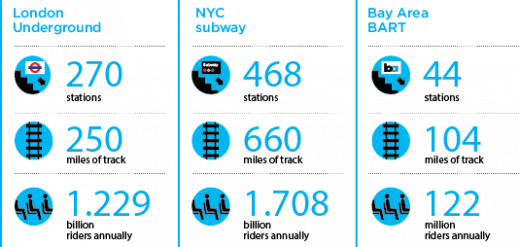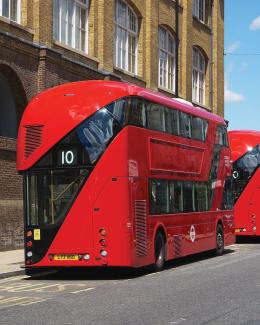London, the first global metropolis, also created the world’s first metropolitan transportation system. In the 150 years since debuting the world’s first subway — and 10 years since being the first major city to introduce a congestion charge—London remains a leader in thinking about ways to move people around a dense and growing urban area.
London’s system is extensive, multimodal and includes a mix of public and private transit services. The 607-square-mile Greater London area is served by 11 London Underground lines, over 700 bus routes and a plethora of other modes, including national rail, tram and ferry service, as well as a vast network of roads accommodating a growing number of bicycle and pedestrian trips. In the past 20 years, public transportation use has increased from 24 percent to 36 percent of trips, while private car trips have decreased from 50 percent to 37 percent.

As London’s system is so much larger, it is somewhat of a stretch to imagine the Bay Area emulating it, but there are lessons we can learn from the performance of London’s transportation network. Here are some of our key observations:
1. Walkability supports transit; transit supports walkability.
Good transit relies on walkability — people don’t use transit unless it delivers them to destinations that are pedestrian-friendly. Even though London has relatively low residential densities by global city standards, it is famously walkable, with a fine-grained block pattern, buildings oriented to the streets, good lighting and all the other ingredients that make it natural and comfortable to get around on foot.
2. Product design matters in transit.
London’s buses attract over two billion riders per year, two times the ridership of the popular Underground system. In stark contrast to most U.S. metro areas where public buses suffer from a poor public image, London’s buses are iconic. The bright-red, doubledecker buses are attractive and efficiently designed, not to mention fun to ride. The system has its own travails, including the usual challenges of slow journey times on crowded streets, but the good product design has had a powerful influence on public perception and usage. Owen Heatherwick designed the latest generation of stylish double-decker buses, which have two flights of stairs (one in the front and one at the back) and, like the traditional buses, a rear platform for easy access. (see image at right).
3. High farebox recovery is possible.
Fares paid by riders cover 70 percent of the cost of operating London’s public transportation systems. By contrast, New York MTA recovers 51 percent of its costs in fares, and San Francisco’s Muni recovers only 22 percent. How does Transport for London (TfL) do it? Their success is due to a combination of regular rate hikes and a policy of aggressively reducing operating costs. TfL was an early adopter of electronic ticketing (they use the Oyster card, which is similar to our Clipper Card), which reduced the need for extensive ticketing infrastructure and personnel, as well as driverless trains (it is TfL’s goal to move to a fully automated subway fleet in coming years). In order to speed up boarding times, buses no longer accept cash. Fares must be bought with a ticket at the bus stop before boarding or by Oyster Card. The result is a system that is more efficient, safer and less expensive to run. [1]
4. Contracts for service can be part of the delivery model.
Most transit services in London are managed by TfL, the executive agency headed by the Mayor of London. TfL is responsible for the planning of and capital investments in the region’s bus and rail services, as well as for overseeing operations of its lines, but TfL also contracts out provision of service for several of its systems to private operators. The government sets routes, fares and performance targets, and puts both the provision of the stock (in the case of buses) and their operation out to a competitive bidding process. Interestingly, several of the bus operators are European agencies such as RATP, the Paris transit operator; Abello, the Dutch Railways operator; and DB, Germany’s railway operator. Results have been mixed for London riders — although rail privatization has largely been considered a failure, bus privatization in London has seen steady service and ridership levels, and it has contributed to reduced TfL operating costs.
5. Transit investments can shape growth, not just react to it.
London has a history of making transit investments that lead demand and shape future growth. Many of London’s commuter rail lines were constructed in the latter part of the 19th century and early part of the 20th century with the goal of providing access from the emerging inner and outer London suburbs to employment in Central London. The Metropolitan Railway pioneered the building of suburban districts along its lines in northwest London in what became known as Metroland.
This is a remarkably different paradigm than in U.S. cities, where even our best systems come into being only after significant growth occurs and demand exists, often in the form of excruciating congestion. BART was built largely on the alignments of former railroad lines, but only after low-density suburban sprawl developed. London is again making major transit investments to direct growth. Several mega projects including Crossrail 1 — a $22-billion, 75-milelong east/west line with 13 miles of tunnels beneath Central London — will increase capacity by 10 percent when it opens in 2018. Crossrail 2 is in planning stages and will run north/south to relieve congestion on some of the most crowded lines. The London Overground, a new orbital line, is planned to expand and connect several of the emerging employment centers in the inner suburbs. High Speed 2 (HS2) will complement HS1 from the Channel Tunnel by providing a new high-speed rail link with the Midlands and North and will achieve many of the goals that the California high-speed rail network aspires to. In short, London is investing several orders of magnitude more to its transit system than most U.S. cities.
6. Congestion pricing has been a success.
One of Mayor Ken Livingstone’s first initiatives was to introduce congestion charging into Central London as an essential tool for allowing London to move more people in and out of the core. The Underground is over capacity, and it is too costly to add more lines. Th only option was moving more people on the surface. It takes up more than 10 times as much street space to move a person in a car than in any other mode. As congestion increased on the surface, the number of people London’s streets moved was in sharp decline. London realized that in order to move more people — and make it possible to drive when people needed to — they needed to sharply reduce their congestion problem and invest in more efficient modes of surface transport. They also understood that all they needed was a 10 percent mode shift to nearly eliminate congestion.
Many also saw it as a method to create and guarantee a constant stream of revenue for London’s aging transport system. London now has a system where road users pay the equivalent of $20 a day ($35 proposed for polluting diesel vehicles) to drive in or through a carefully defined area of Central London. The system is monitored through license plate-reading cameras at the perimeter of the zone, while payment is made online or at machines throughout the city. Special dispensations are made for local residents, the disabled and essential workers such as doctors, nurses or firemen. The result has been an improvement in the flow of traffic and air quality and a noticeable increase in the number of buses, taxis and cyclists. Whereas before it was frequently faster to walk, since buses and cars were all snarled together in seemingly perpetual gridlock, now getting around the central area is relatively easy.
London’s transportation system is not perfect, and predicted population growth from 8.3 million to 10 million by 2030 will put ever more pressure on its network. But there is no doubt London has built up a huge, well-used and efficient transit system that is integral to the functioning of the city.
Endnotes
[1] 1 See Eric Jaffe’s great piece on the subject of TfL’s financial effectiveness, “5 Lessons U.S. Transit Systems Should Learn from London" (citylab.com).

